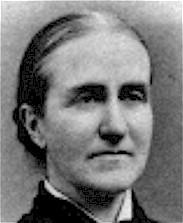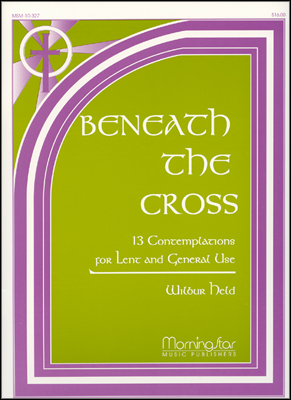- |
User Links
Beneath the Cross of Jesus

Beneath the cross of Jesus I fain would take my stand
Author: Elizabeth Cecilia Clephane (1868)Tune: ST. CHRISTOPHER (Maker)
Gospel Acclamation Songs
Published in 541 hymnals
Printable scores: PDF, MusicXMLPlayable presentation: Lyrics only, lyrics + musicAudio files: MIDI, Recording
Representative Text
1. Beneath the cross of Jesus
I fain would take my stand;
The shadow of a mighty rock
Within a weary land;
A home within the wilderness,
A rest upon the way,
From burns beneath the noontide heat
And burdens of the day.
2. Upon that cross of Jesus
Mine eyes at times can see
The very dying form of One
Who suffer'd there for me;
And from my striken heart, with tears,
Two wonders I confess:
The wonders of redeeming love,
And my unworthiness.
3. O safe and happy shelter!
O refuge tried and sweet!
O sacred place where Heaven's love
And Heaven's justice meet!
As to the exil'd patriarch
That wondrous dream was given,
So seems my Savior's cross to me:
A ladder up to Heav'n.
4. I take, O cross, your shadow
For my abiding place;
I ask no other sunshine than
The sunshine of his face;
Content to let the world go by,
To know no gain or loss;
My sinful self my only shame,
My glory all the cross.
Source: Hymns and Devotions for Daily Worship #126c
Author: Elizabeth Cecilia Clephane
 Clephane, Elizabeth Cecilia, third daughter of Andrew Clephane, Sheriff of Fife, was born at Edinburgh, June 18, 1830, and died at Bridgend House, near Melrose, Feb. 19, 1869. Her hymns appeared, almost all for the first time, in the Family Treasury, under the general title of Breathings on the Border. In publishing the first of these in the Treasury, the late Rev. W. Arnot, of Edinburgh, then editor, thus introduced them:—
"These lines express the experiences, the hopes, and the longings of a young Christian lately released. Written on the very edge of this life, with the better land fully, in the view of faith, they seem to us footsteps printed on the sands of Time, where these sands touch the ocean of Eternity. These footprints of one… Go to person page >
Clephane, Elizabeth Cecilia, third daughter of Andrew Clephane, Sheriff of Fife, was born at Edinburgh, June 18, 1830, and died at Bridgend House, near Melrose, Feb. 19, 1869. Her hymns appeared, almost all for the first time, in the Family Treasury, under the general title of Breathings on the Border. In publishing the first of these in the Treasury, the late Rev. W. Arnot, of Edinburgh, then editor, thus introduced them:—
"These lines express the experiences, the hopes, and the longings of a young Christian lately released. Written on the very edge of this life, with the better land fully, in the view of faith, they seem to us footsteps printed on the sands of Time, where these sands touch the ocean of Eternity. These footprints of one… Go to person page >Text Information
Related Texts
| First Line: | Beneath the cross of Jesus I fain would take my stand |
| Title: | Beneath the Cross of Jesus |
| Author: | Elizabeth Cecilia Clephane (1868) |
| Meter: | 7.6.8.6.8.6.8.6 |
| Place of Origin: | Scotland |
| Language: | English |
| Notes: | Spanish translations: See "Junto a la cruz de Cristo" by George Paul Simmonds, "Confío yo en Cristo"; Swahili translation: See "Nataka kusimama" |
| Copyright: | Public Domain |
| Liturgical Use: | Gospel Acclamation Songs |
| Article: | Old Testament Images of the Cross in "Beneath the Cross of Jesus" by Esther Rothenbusch (from The Hymn) |
- Year A, Lent, First Sunday
- Year A, Lent, Palm Sunday
This is recommended for Year A, Lent, Palm Sunday by 2 hymnal lectionary indexes including Lift Up Your Hearts: psalms, hymns, and spiritual songs #167. - Year A, Holy Week season, Monday of Holy Week
This is recommended for Year A, Holy Week season, Monday of Holy Week by 2 hymnal lectionary indexes including Glory to God: the Presbyterian Hymnal #216. - Year A, Holy Week season, Tuesday of Holy Week
This is recommended for Year A, Holy Week season, Tuesday of Holy Week by 3 hymnal lectionary indexes including Glory to God: the Presbyterian Hymnal #216 and Lift Up Your Hearts: psalms, hymns, and spiritual songs #167. - Year A, Holy Week season, Good Friday
This is recommended for Year A, Holy Week season, Good Friday by 3 hymnal lectionary indexes including Glory to God: the Presbyterian Hymnal #216. - Year B, Lent, Third Sunday
This is recommended for Year B, Lent, Third Sunday by 2 hymnal lectionary indexes including Lift Up Your Hearts: psalms, hymns, and spiritual songs #167. - Year B, Lent, Fourth Sunday
- Year B, Lent, Fifth Sunday
This is recommended for Year B, Lent, Fifth Sunday by 2 hymnal lectionary indexes. - Year B, Holy Week season, Monday of Holy Week
This is recommended for Year B, Holy Week season, Monday of Holy Week by 2 hymnal lectionary indexes including Glory to God: the Presbyterian Hymnal #216. - Year B, Holy Week season, Tuesday of Holy Week
This is recommended for Year B, Holy Week season, Tuesday of Holy Week by 3 hymnal lectionary indexes including Glory to God: the Presbyterian Hymnal #216 and Lift Up Your Hearts: psalms, hymns, and spiritual songs #167. - Year B, Holy Week season, Good Friday
This is recommended for Year B, Holy Week season, Good Friday by 3 hymnal lectionary indexes including Glory to God: the Presbyterian Hymnal #216. - Year C, Lent, Palm Sunday
- Year C, Holy Week season, Monday of Holy Week
This is recommended for Year C, Holy Week season, Monday of Holy Week by 2 hymnal lectionary indexes including Glory to God: the Presbyterian Hymnal #216. - Year C, Holy Week season, Tuesday of Holy Week
This is recommended for Year C, Holy Week season, Tuesday of Holy Week by 3 hymnal lectionary indexes including Glory to God: the Presbyterian Hymnal #216 and Lift Up Your Hearts: psalms, hymns, and spiritual songs #167. - Year C, Holy Week season, Good Friday
This is recommended for Year C, Holy Week season, Good Friday by 3 hymnal lectionary indexes including Glory to God: the Presbyterian Hymnal #216. - Year C, Ordinary Time, Proper 9 (14)
This is recommended for Year C, Ordinary Time, Proper 9 (14) by 3 hymnal lectionary indexes including Lift Up Your Hearts: psalms, hymns, and spiritual songs #167. - Year C, Ordinary Time, Proper 29 (34)
This is recommended for Year C, Ordinary Time, Proper 29 (34) by 2 hymnal lectionary indexes including Glory to God: the Presbyterian Hymnal #216.
Chinese
English
- 112 Familiar Hymns and Gospel Songs #2
- A Selection of Hymns #d8
- A Service Hymn Book #d12
- A Treasury of Hymns: The best-loved hymns, carols, anthems, children's hymns, and gospel songs #33
- A. M. E. C. Hymnal #130
- A.M.E. Hymnal: with responsive scripture readings...(The Richard Allen A.M.E. Hymnal) #d47
- Abiding Songs #d12
- African American Heritage Hymnal #247
- African Methodist Episcopal Church Hymnal #146
- Alexander's Male Choir #d6 10 shown out of 412
Spanish
For Leaders
Text:
Elizabeth C. Clephane (1830-1869) wrote this hymn. Of the eight of her hymns that were published posthumously between 1872 and 1874 in Family Treasury, a Scottish Presbyterian magazine, this is one of the first group to appear.
The second line of the hymn contains an archaic expression that is rarely changed: “I fain would take my stand.” Worship and Rejoice has a modernized version of the line: “I gladly take my stand.” Another notable line is the fourth line of the third stanza, “Content to let the world go by,” which is often seen as escapist, but it could also be seen as an admission of the true worth of this world, which will pass away.
The first stanza describes the meaning of the cross, the second, the meaning of the One who died there, and the third, the great difference in worth between the two.
Tune:
This hymn is always sung to ST. CHRISTOPHER, which was written for this text by Frederick C. Maker for the 1881 Supplement to the Bristol Tune Book. The name of the tune is also the name of the patron saint of travelers, but it is not known if that connection was deliberate or accidental. The tune and its harmonization are very chromatic, and though the last phrase begins with an augmented fourth – a difficult interval for congregations to sing – its top note feels like a continuation of the ascending scale of the previous phrase. (Paul Westermeyer, Let the People Sing, p. 257)
When/Why/How:
This hymn is usually sung during Lent or Holy Week. It would also be a good choice for those occasions when a congregation is going through a difficult time, perhaps dealing with a tragedy to one of their members, because it reminds us where to find strength and rest.
A simple choral setting of this hymn suitable for small choirs can be found in "Hymns We Love to Sing", with an original refrain after the second and third stanzas. The collection "The Road to Redemption" includes an organ and piano duet setting of ST. CHRISTOPHER. For a trumpet solo based on this hymn, look in "Trumpet Stylings" by Jack Schrader. A moderately difficult violin solo, "Beneath the Cross/Jesus, I My Cross Have Taken" is expressive, but requires the frequent use of double stops.
Tiffany Shomsky, Hymnary.org
Timeline
Arrangements
Media
Small Church Music #5906
- PDF Score (PDF)
The United Methodist Hymnal #297
- MIDI file from Baptist Hymnal 1991 #291
- MIDI file from Baptist Hymnal 1991 #291
- Audio recording from Baptist Hymnal 2008 #238
- MIDI file from The Cyber Hymnal #664
- Audio recording from Evangelical Lutheran Worship #338
- Audio recording from Glory to God: the Presbyterian Hymnal #216
- Audio recording from Lift Up Your Hearts: psalms, hymns, and spiritual songs #167
- Audio recording from Lift Up Your Hearts: psalms, hymns, and spiritual songs #167
- Audio recording from Small Church Music #35
- Audio recording from Small Church Music #35
- Audio recording from Small Church Music #35
- Audio recording from Small Church Music #5906
- Audio recording from Small Church Music #5906
- Audio recording from Small Church Music #5906
- Audio recording from Trinity Hymnal (Rev. ed.) #251
- Audio recording from The Worshiping Church #216
- MIDI file from The United Methodist Hymnal #297
- Audio recording from The United Methodist Hymnal #297
- Audio recording from Worship and Rejoice #255
- MIDI file from Worship and Rejoice #255


 My Starred Hymns
My Starred Hymns







